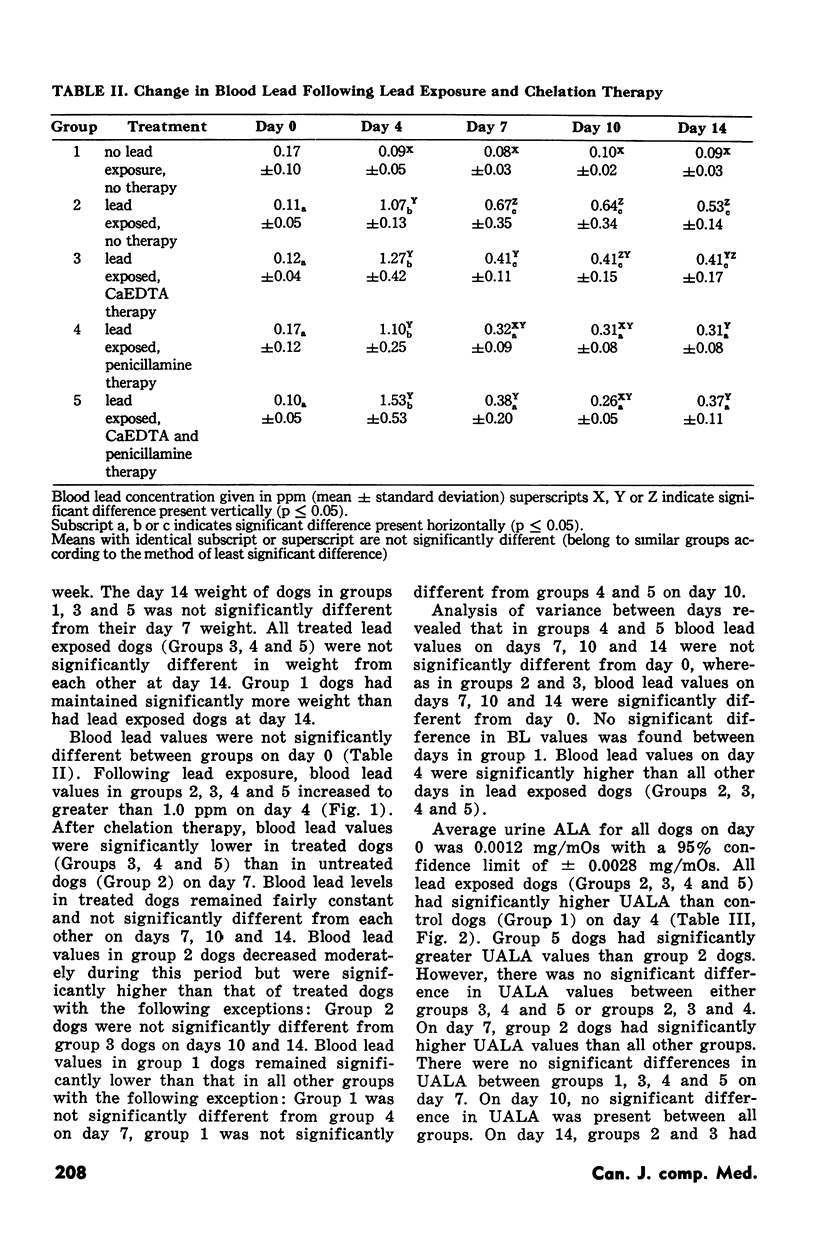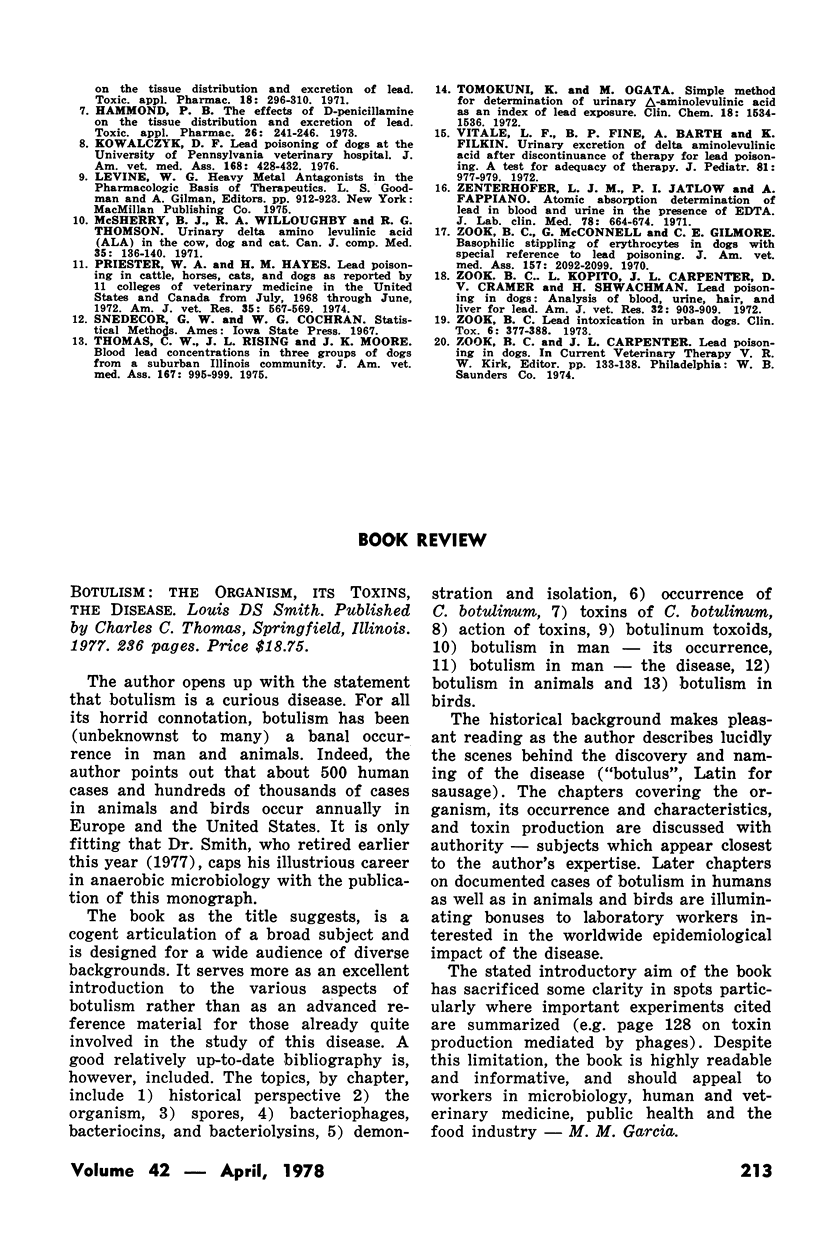Abstract
Intravenous lead administration to dogs produced an acute syndrome of lead intoxication charcterized by depression, vomiting, anorexia and weight loss. The effect of chelation therapy with calcium disodium ethylene diamine tetraacetate, penicillamine or both was determined by serially monitoring changes in blood lead and urine delta-aminolevulinic acid. Following therapy, blood lead values were significantly lower in chelated dogs than non-treated lead exposed dogs on days 7 and 10. Urine delta-aminolevulinic acid at day 7 was significantly higher in untreated lead exposed dogs than in other groups. There was no significant difference in blood lead or urine delta-aminolevulinic acid between lead intoxicated dogs which underwent the indicated chelation therapy protocols. There was, however, a trend for higher urinary delta-aminolevulinic acid excretion in those intoxicated dogs undergoing calcium disodium ethylene diamine tetraacetate therapy as opposed to those undergoing penicilamine therapy. There was no significant correlation between blood lead and urinary delta-aminolevulinic acid previous to lead exposure. However, after lead exposure significant correlation was present at days 4, 7, 10 and 14. Certain lead exposed dogs following chelation therapy were noted to have normal blood lead levels but elevated urinary delta-aminolevulinic acid suggesting that blood lead does not always correlate with metabolic effects of lead in the body. Urinary delta-aminolevulinic acid was therefore recommended as an additional laboratory parameter which improved assessment of lead exposure in dogs, particularly in determining adequacy of chelation therapy.
Full text
PDF








Selected References
These references are in PubMed. This may not be the complete list of references from this article.
- Barnes J. R., Smith P. E., Drummond C. M. Urine osmolality and -aminolevulinic acid excretion. Arch Environ Health. 1972 Dec;25(6):450–455. doi: 10.1080/00039896.1972.10666202. [DOI] [PubMed] [Google Scholar]
- Chisolm J. J., Jr, Barrett M. B., Harrison H. V. Indicators of internal dose of lead in relation to derangement in heme synthesis. Johns Hopkins Med J. 1975 Jul;137(1):6–12. [PubMed] [Google Scholar]
- Chisolm J. J., Jr The use of chelating agents in the treatment of acute and chronic lead intoxication in childhood. J Pediatr. 1968 Jul;73(1):1–38. doi: 10.1016/s0022-3476(68)80036-8. [DOI] [PubMed] [Google Scholar]
- Clarke E. G. Lead poisoning in small animals. J Small Anim Pract. 1973 Apr;14(4):183–194. doi: 10.1111/j.1748-5827.1973.tb06916.x. [DOI] [PubMed] [Google Scholar]
- Hammond P. B. The effects of D-penicillamine on the tissue distribution and excretion of lead. Toxicol Appl Pharmacol. 1973 Oct;26(2):241–246. doi: 10.1016/0041-008x(73)90257-3. [DOI] [PubMed] [Google Scholar]
- Hammond P. B. The effects of chelating agents on the tissue distribution and excretion of lead. Toxicol Appl Pharmacol. 1971 Feb;18(2):296–310. doi: 10.1016/0041-008x(71)90121-9. [DOI] [PubMed] [Google Scholar]
- Kowalczyk D. F. Lead poisoning in dogs at the University of Pennsylvania Veterinary Hospital. J Am Vet Med Assoc. 1976 Mar 1;168(5):428–432. [PubMed] [Google Scholar]
- McSherry B. J., Willoughby R. A., Thomson R. G. Urinary delta amino levulinic acid (ALA) in the cow, dog and cat. Can J Comp Med. 1971 Apr;35(2):136–140. [PMC free article] [PubMed] [Google Scholar]
- Thomas C. W., Rising J. L., Moore J. K. Blood lead concentrations in three groups of dogs from a suburban Illinois community. J Am Vet Med Assoc. 1975 Dec 1;167(11):995–999. [PubMed] [Google Scholar]
- Tomokuni K., Ogata M. Simple method for determination of urinary -aminolevulinic acid as an index of lead exposure. Clin Chem. 1972 Dec;18(12):1534–1538. [PubMed] [Google Scholar]
- Vitale L. F., Fine B. P., Barth A., Filkin K. Urinary excretion of delta aminolevulinic acid after discontinuance of therapy for lead poisoning. A test for adequacy of therapy. J Pediatr. 1972 Nov;81(5):977–979. doi: 10.1016/s0022-3476(72)80554-7. [DOI] [PubMed] [Google Scholar]
- Zinterhofer L. J., Jatlow P. I., Fappiano A. Atomic absorption determination of lead in blood and urine in the presence of EDTA. J Lab Clin Med. 1971 Oct;78(4):664–674. [PubMed] [Google Scholar]
- Zook B. C., Kopito L., Carpenter J. L., Cramer D. V., Shwachman H. Lead poisoning in dogs: analysis of blood, urine, hair, and liver for lead. Am J Vet Res. 1972 May;33(5):903–909. [PubMed] [Google Scholar]
- Zook B. C. Lead intoxication in urban dogs. Clin Toxicol. 1973;6(3):377–388. doi: 10.3109/15563657308990538. [DOI] [PubMed] [Google Scholar]
- Zook B. C., McConnell G., Gilmore C. E. Basophilic stippling of erythrocytes in dogs with special reference to lead poisoning. J Am Vet Med Assoc. 1970 Dec 15;157(12):2092–2099. [PubMed] [Google Scholar]


